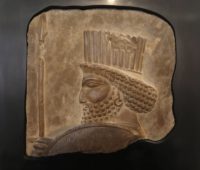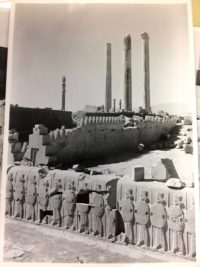 An ancient Persian bas-relief that has been stolen twice in two places across the world from each other has returned to Iran. It is a carved slab of limestone eight inches square depicting a curly-bearded “Immortal” (imperial guard) from the Achaemenid dynasty. He was one of a long line of soldier reliefs arrayed in precise formation on a balustrade besides the steps of Persepolis’ main building. They were carved between 510 and 330 B.C.
An ancient Persian bas-relief that has been stolen twice in two places across the world from each other has returned to Iran. It is a carved slab of limestone eight inches square depicting a curly-bearded “Immortal” (imperial guard) from the Achaemenid dynasty. He was one of a long line of soldier reliefs arrayed in precise formation on a balustrade besides the steps of Persepolis’ main building. They were carved between 510 and 330 B.C.
The bas-relief was discovered in Persepolis in a 1933 excavation of the site by the Oriental Institute of the University of Chicago. Contemporary photographs show the relief in situ, part of a line of imperial soldiers. Photographs show it still in place and untouched at least up to 1936. After that it vanished, reappearing 15 years later in the hands of French antiquities dealer and expert in Mediterranean sculpture Paul Mallon. Mallon sold it to Canadian department store heir and collector Frederick Cleveland Morgan for a comparative pittance ($1,000). Morgan donated the relief to the Montreal Museum of Fine Arts in the 1950s. It was on display there for six decades.
 It was stolen again in September 2011 when a man wearing jeans, a dark jacket and a baseball cap casually walked into the museum in broad daylight and walked out with the Persian relief and a 1st century Roman marble head of a man. The brazen crime was never solved, but the bas relief was found in January of 2014 in the Edmonton home of a collector who claimed he thought it was a replica when he bought it from “a friend of a friend” for $1400 Canadian.
It was stolen again in September 2011 when a man wearing jeans, a dark jacket and a baseball cap casually walked into the museum in broad daylight and walked out with the Persian relief and a 1st century Roman marble head of a man. The brazen crime was never solved, but the bas relief was found in January of 2014 in the Edmonton home of a collector who claimed he thought it was a replica when he bought it from “a friend of a friend” for $1400 Canadian.
The Montreal Museum of Fine Arts decided to keep the $950,000 insurance payout it received after the theft and let its insurer, AXA, keep the title to the relief. AXA sold it to British antiquities dealer Rupert Wace. In October 2017, Wace offered the piece for sale for $1.2 million at The European Fine Art Fair (TEFAF). There it was, exposed to some of New York City’s deepest pockets, when the cops and city prosecutors waltzed in and seized it. The vociferous protests of the dealers — apparently the language got a tad bluer than the TEFAF crowd is accustomed to — fell on deaf ears.
Wace and his partner were shocked because the relief had been published and displayed extensively for 80 years, long before the 1970 UNESCO convention cutoff on the illegal export of cultural artifacts, but the Manhattan district attorney’s office was acting on evidence that the relief had been stolen after Persian passed the Cultural Heritage Protection Act in 1930 prohibiting the export of such artifacts.
The Manhattan DA created a full timeline of tracing the location and ownership history of the relief. Their contention was that nobody could own stolen property “in good faith” because there is no valid title to transfer in a sale and because the buyer should do his due diligence in ascertaining the reality of an object’s provenance instead of relying on conjecture. In this case, dealers said they just assumed the bas-relief had been looted from Persepolis in the 19th century. They had no evidence to support that hypothesis nor did they make any effort to determine its veracity.
In July of this year, a New York Supreme Court judge ordered that the relief be repatriated to Iran. After some negotiations, the London dealers agreed to fork it over. As of this week, the relief is back on Persian soil.
“It now belongs to the people who made it in the first place, and who are now going to preserve it, and is part of their identity,” Firouzeh Sepidnameh, director of the ancient history section of the National Museum told AFP on Tuesday.
The limestone relief was handed over to Iran’s representative at the United Nations last month and was personally brought back to Iran by President Hassan Rouhani, returning from the UN General Assembly.
“Shocked, shocked…!” 😆
“They were carved between 510 and 330 BC” – For real! – That would be between the foundation of Persepolis and its destruction, in other words, not really a surprise 😀
According to Herodotus’ Book VII, however, seemingly the only thing immortal about those “immortals” was their number of ten thousand, and that there were people, who “epersen” particularly Persepolis is probably likewise no surprise.
————
(1). Now when the report came to Dareios the son of Hystaspes of the battle which was fought at Marathon, the king, who even before this had been greatly exasperated with the Athenians on account of the attack made upon Sardis, then far more than before displayed indignation, and was far more desirous of making a march against Hellas. …
…and about the generals assembly and those “immortals”…
(83). …These were generals of the whole together that went on foot, excepting the ten thousand; and of these ten thousand chosen Persians the general was Hydarnes the son of Hydarnes; and these Persians were called “Immortals,” because, if any one of them made the number incomplete, being overcome either by death or disease, another man was chosen to his place, and they were never either more or fewer than ten thousand. …
Next thing you know the New York Supreme Court will return the USA to the Red Indians. (And to the Hawaiians, Esquimaux, and so on.)